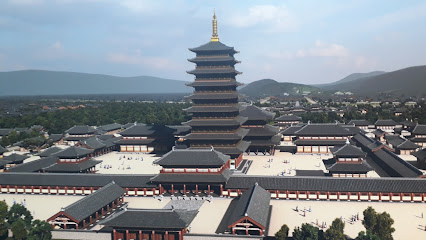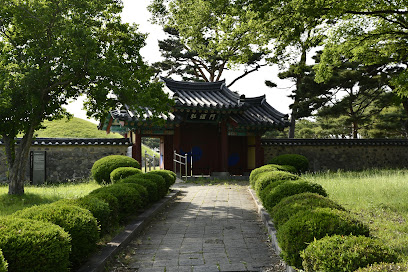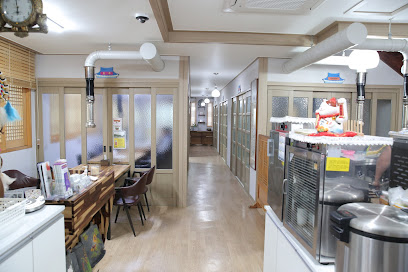
Bomun-dong: The Heart of Gyeongju's Ancient Charm
Explore Bomun-dong in Gyeongju: A harmonious blend of ancient history, cultural treasures, and scenic beauty, offering an enriching experience for every traveler.
Bomun-dong, nestled in the historical city of Gyeongju, South Korea, is a captivating blend of ancient history and natural beauty. Known as the 'museum without walls,' this neighbourhood offers a rich tapestry of cultural and historical sites, making it a must-visit for any traveler. The serene Bomun Lake is the centerpiece of this area, surrounded by lush landscapes and dotted with traditional Korean pavilions, offering a tranquil escape from the hustle and bustle of city life. A short stroll around Bomun-dong will reveal several UNESCO World Heritage sites. The Bulguksa Temple, a masterpiece of Buddhist art and architecture, is a highlight. Nearby, the Seokguram Grotto, housing a magnificent statue of Buddha, offers a spiritual experience with breathtaking views of the East Sea. The Gyeongju National Museum is another gem, showcasing artifacts that tell the story of Korea's Silla Dynasty. For those seeking leisure activities, Bomun-dong doesn't disappoint. The area is home to several high-end resorts, golf courses, and the Gyeongju World Amusement Park, providing fun for families and adventure seekers alike. The neighbourhood's vibrant food scene, featuring traditional Korean cuisine, adds to its charm, making Bomun-dong a perfect blend of history, culture, and modern amenities.
Local tips in Bomun-dong
- Visit early in the morning to avoid crowds at popular sites like Bulguksa Temple and Seokguram Grotto.
- Rent a bike to explore the area around Bomun Lake for a more immersive experience.
- Try the local speciality, Gyeongju bread (Hwangnam-ppang), from a nearby bakery.
- Check the schedule for cultural performances and festivals at the Bomun Lake Resort.
- Wear comfortable shoes as many attractions involve walking and hiking.
Bomun-dong: The Heart of Gyeongju's Ancient Charm
Bomun-dong, nestled in the historical city of Gyeongju, South Korea, is a captivating blend of ancient history and natural beauty. Known as the 'museum without walls,' this neighbourhood offers a rich tapestry of cultural and historical sites, making it a must-visit for any traveler. The serene Bomun Lake is the centerpiece of this area, surrounded by lush landscapes and dotted with traditional Korean pavilions, offering a tranquil escape from the hustle and bustle of city life. A short stroll around Bomun-dong will reveal several UNESCO World Heritage sites. The Bulguksa Temple, a masterpiece of Buddhist art and architecture, is a highlight. Nearby, the Seokguram Grotto, housing a magnificent statue of Buddha, offers a spiritual experience with breathtaking views of the East Sea. The Gyeongju National Museum is another gem, showcasing artifacts that tell the story of Korea's Silla Dynasty. For those seeking leisure activities, Bomun-dong doesn't disappoint. The area is home to several high-end resorts, golf courses, and the Gyeongju World Amusement Park, providing fun for families and adventure seekers alike. The neighbourhood's vibrant food scene, featuring traditional Korean cuisine, adds to its charm, making Bomun-dong a perfect blend of history, culture, and modern amenities.
Iconic landmarks you can’t miss
Gyeongju National Museum
Immerse yourself in the rich history of Korea at Gyeongju National Museum, showcasing treasures from the Silla Dynasty in an architectural marvel.

Gyeongju Bird Park
Discover the vibrant avian world at Gyeongju Bird Park, where nature's beauty and wildlife conservation come together in a breathtaking setting.

Bomunho Lake
Experience the natural beauty and cultural richness of Bomunho Lake in Gyeongju, a perfect destination for relaxation and recreation.

Gyeongju East Palace Garden
Explore the breathtaking Gyeongju East Palace Garden, a serene botanical sanctuary rich with history and natural beauty in the heart of Gyeongju.

Bunhwangsa
Discover the tranquil beauty and spiritual heritage of Bunhwangsa, an ancient Buddhist temple in Gyeongju, a must-visit for cultural enthusiasts and peace seekers.

Hwangnyongsa Temple Site
Explore the Hwangnyongsa Temple Site, a historical gem in Gyeongju, showcasing the architectural splendor of the Silla Dynasty.

Bomunjeong Pavilion
Discover the tranquil beauty of Bomunjeong Pavilion, a stunning lakeside attraction in Gyeongju, South Korea, blending culture and nature seamlessly.

Seondeogyeowangneung Royal Tomb of Queen Seondeok
Explore the Seondeogyeowangneung Royal Tomb of Queen Seondeok in Gyeongju, a UNESCO World Heritage site rich in history and stunning natural beauty.

Tomb of King Sinmun of Silla
Explore the majestic Tomb of King Sinmun of Silla, a UNESCO World Heritage site in Gyeongju, revealing the rich history of Korea's ancient Silla Dynasty.

Myeonghwalsanseong Fortress
Uncover the historical charm and natural beauty of Myeonghwalsanseong Fortress, a symbol of Korea's rich heritage in Gyeongju.

Unmissable attractions to see
Cheomseongdae Observatory
Explore the ancient wonders of Cheomseongdae, the oldest astronomical observatory in East Asia, nestled in the heart of Gyeongju's historic landscape.

Donggung Palace & Wolji Pond
Experience the historic elegance of Donggung Palace & Wolji Pond, a serene escape into Korea's royal heritage surrounded by breathtaking landscapes.

Gyeongju National Museum
Discover the rich heritage of Korea at the Gyeongju National Museum, showcasing the treasures of the ancient Silla Kingdom.

Gyeongju World
Discover thrilling rides and rich culture at Gyeongju World, a premier theme park blending excitement with Korea's historical heritage.

Daereungwon Tomb Complex
Immerse yourself in the rich history of the Silla Dynasty at the Daereungwon Tomb Complex, a UNESCO World Heritage Site in Gyeongju, South Korea.

Gyeongju Bird Park
Explore the vibrant world of avian life at Gyeongju Bird Park, where nature and adventure come together in a scenic setting.

Bomunho Lake
Explore the scenic beauty and cultural heritage of Bomunho Lake in Gyeongju, a perfect retreat for relaxation and outdoor activities.

Gyeongju Tower
Discover the breathtaking views and rich history at Gyeongju Tower, the iconic landmark of Gyeongju, South Korea.

Gyeongju East Palace Garden
Explore the enchanting Gyeongju East Palace Garden, a botanical paradise where tranquility meets historical beauty in the heart of Gyeongju.

Myeonghwalsanseong Fortress
Discover the historical marvel of Myeonghwalsanseong Fortress in Gyeongju, where history meets breathtaking natural beauty.

Essential places to dine
맷돌순두부
Experience authentic Korean cuisine at 맷돌순두부 in Gyeongju – a perfect blend of tradition and taste.

Venzamas
Experience the best brunch in Gyeongju at Venzamas—where tradition meets modern dining!

우마왕 본점
Experience authentic Korean cuisine at 우마왕 본점 in Gyeongju-si – where every dish tells a story.

전주가
Experience authentic Korean cuisine at Jeonju-ga in Gyeongju-si, where tradition meets flavor in every delightful dish.

토함혜
Experience authentic Korean cuisine at Tohamhye in Gyeongju - where tradition meets taste in every dish.

Arirang Restaurant
Experience authentic Korean flavors at Arirang Restaurant in Gyeongju – where tradition meets taste in every dish.

나현숯불생오리
Indulge in authentic Korean barbecue at 나현숯불생오리 in Gyeongju-si, where fresh ingredients meet rich tradition.

달개비
Experience authentic Korean cuisine at 달개비 in Gyeongju – where tradition meets flavor in every dish.

두갈고
Experience authentic Korean flavors at 두갈고 in Gyeongju-si – a culinary gem offering traditional dishes and warm hospitality.

유황오리전문점남촌
Savor authentic Korean duck delicacies in Gyeongju's charming atmosphere at 유황오리전문점남촌.

Markets, malls and hidden boutiques
보문콜로세
Shop, dine, and experience the vibrant culture at 보문콜로세, Gyeongju's premier shopping destination.

경주특산명과의집
Discover the rich flavors of Gyeongju at 경주특산명과의집, where traditional Korean baking meets modern culinary artistry.

보문 콜로세움
Discover the vibrant shopping and dining experience at 보문 콜로세움 in Gyeongju-si, where culture meets modern retail.

망고홈 Mango Home
Explore Mango Home in Gyeongju for unique gifts and local handicrafts that capture the spirit of Korean culture.

쁘띠지우
Explore the unique charm of 쁘띠지우 in Gyeongju, where local craftsmanship meets delightful shopping in a cozy internet shop atmosphere.

그린쇼핑
Explore the vibrant shopping scene at 그린쇼핑 in Gyeongju, where local culture meets modern retail for an unforgettable experience.

노을레드블라인드
Explore stylish window treatments at 노을레드블라인드, a unique blinds shop in historic Gyeongju, offering local craftsmanship and modern designs.

소품이야기
Explore the enchanting world of 소품이야기, a unique stationery store in Gyeongju offering beautifully crafted items reflecting local art and culture.

Jeongdowon
Explore Jeongdowon, the premier health food store in Gyeongju-si, offering organic delights and wellness insights for health-conscious travelers.

Pulmuwon
Discover Pulmuwon in Gyeongju, a health food store offering organic products and wellness items perfect for health-conscious travelers.

Essential bars & hidden hideouts
Bar분 (Bar Boon)
Experience the vibrant nightlife of Gyeongju at Bar Boon, where local flavors meet innovative cocktails in a chic setting.

Heuheuheu
Discover Heuheuheu in Gyeongju: a vibrant bar with a wide selection of craft beers and delicious food, perfect for tourists seeking local flavors.

Gyeongju Cocktail Bar ELJEFE CUBANOS Pub
Discover the essence of Cuba at ELJEFE CUBANOS, a vibrant cocktail bar in Gyeongju. Savor authentic dishes and expertly crafted cocktails in a lively atmosphere.

Round2 restaurant & pub
Discover the vibrant nightlife of Gyeongju at Round2 Restaurant & Pub, where delightful drinks and delicious food await in a lively atmosphere.

Bar Prep
Experience Gyeongju's vibrant nightlife at Bar Prep, where unique cocktails and breathtaking views create an unforgettable ambiance.

Little Rock
Explore Little Rock's vibrant nightlife, where eclectic bars and friendly locals create a welcoming atmosphere for unforgettable evenings.

Eobuba
Discover the tranquil ambiance and exquisite wine selection at Eobuba, Gyeongju's premier wine bar for a relaxing evening.

Le Jour J
Experience the elegance of French cuisine and fine wines at Le Jour J, Gyeongju's premier wine bar and restaurant.

Habana
Experience the vibrant nightlife at Habana, Gyeongju's trendy bar, where local culture and modern cocktails blend seamlessly.

달빛에술한모금
Enjoy a unique bar experience at 달빛에술한모금 in Gyeongju-si, blending local flavors with a cozy atmosphere for unforgettable evenings.

Local Phrases
-
- Hello안녕하세요
[annyeonghaseyo] - Goodbye안녕히 가세요
[annyeonghi gaseyo] - Yes네
[ne] - No아니요
[aniyo] - Please/You're welcome부탁합니다/천만에요
[butakhamnida/cheonmaneyo] - Thank you감사합니다
[gamsahamnida] - Excuse me/Sorry죄송합니다
[joesonghamnida] - How are you?어떻게 지내요?
[eotteoke jinaeyo?] - Fine. And you?잘 지내요. 당신은요?
[jal jinaeyo. dangsineunyo?] - Do you speak English?영어 할 수 있어요?
[yeongeo hal su isseoyo?] - I don't understand이해하지 못해요
[ihaehaji mothaeyo]
- Hello안녕하세요
-
- I'd like to see the menu, please메뉴를 보고 싶어요
[menyureul bogo sipeoyo] - I don't eat meat고기를 먹지 않아요
[gogireul meokji anayo] - Cheers!건배!
[geonbae!] - I would like to pay, please결제하고 싶어요
[gyeoljehago sipeoyo]
- I'd like to see the menu, please메뉴를 보고 싶어요
-
- Help!도와주세요!
[dowajuseyo!] - Go away!가세요!
[gaseyo!] - Call the Police!경찰을 불러주세요!
[gyeongchareul bulleojuseyo!] - Call a doctor!의사를 불러주세요!
[uisareul bulleojuseyo!] - I'm lost길을 잃었어요
[gireul ilheosseoyo] - I'm ill아파요
[apayo]
- Help!도와주세요!
-
- I'd like to buy...사고 싶어요...
[sago sipeoyo...] - I'm just looking구경만 하고 있어요
[gugyeongman hago isseoyo] - How much is it?얼마에요?
[eolmaeyo?] - That's too expensive너무 비싸요
[neomu bissayo] - Can you lower the price?가격을 낮출 수 있어요?
[gageogeul natchul su isseoyo?]
- I'd like to buy...사고 싶어요...
-
- What time is it?지금 몇 시에요?
[jigeum myeot sieyo?] - It's one o'clock한 시에요
[han sieyo] - Half past (10)10시 반
[sipshi ban] - Morning아침
[achim] - Afternoon오후
[ohu] - Evening저녁
[jeonyeok] - Yesterday어제
[eoje] - Today오늘
[oneul] - Tomorrow내일
[naeil] - 1하나
[hana] - 2둘
[dul] - 3셋
[set] - 4넷
[net] - 5다섯
[daseot] - 6여섯
[yeoseot] - 7일곱
[ilgop] - 8여덟
[yeodeol] - 9아홉
[ahop] - 10열
[yeol]
- What time is it?지금 몇 시에요?
-
- Where's a/the...?...이 어디에 있어요?
[...i eodie isseoyo?] - What's the address?주소가 뭐에요?
[jusoga mwoeyo?] - Can you show me (on the map)?지도로 보여줄 수 있어요?
[jidoro boyeojul su isseoyo?] - When's the next (bus)?다음 (버스)는 언제 와요?
[daeum (beoseu)neun eonje wayo?] - A ticket (to ....)표 하나 주세요 (....으로)
[pyo hana juseyo (....euro)]
- Where's a/the...?...이 어디에 있어요?
History of Bomun-dong
-
Bomun-dong, located near the ancient capital of the Silla Kingdom, has roots that trace back to the 7th century when the region was a significant political and cultural center. The name 'Bomun' translates to 'the door of the phoenix,' symbolizing rebirth and prosperity. This area was historically part of the district that housed palaces and royal tombs, intertwining its identity with the storied past of Gyeongju.
-
In the late 20th century, Bomun-dong underwent significant transformation with the development of Bomun Lake Resort, which opened in the 1970s. This resort area was designed to promote tourism in Gyeongju, capitalizing on the city's rich heritage and natural beauty. It features a range of accommodations, recreational facilities, and cultural experiences, attracting both domestic and international visitors.
-
Bomun-dong hosts various cultural festivals that celebrate the rich history of the Silla Kingdom and local traditions. One notable event is the Gyeongju Cherry Blossom Festival, which occurs every spring, drawing thousands to witness the stunning blossoms around Bomun Lake. Such events foster community spirit and highlight the area’s deep connection to Korea’s cultural heritage.
-
The area surrounding Bomun-dong is dotted with historical sites, including ancient tombs and relics from the Silla Dynasty. Efforts have been made to preserve these sites, ensuring that the cultural significance of Bomun-dong remains intact for future generations. The proximity to UNESCO World Heritage Sites, such as the Gyeongju Historic Areas, further emphasizes Bomun-dong's role in the broader narrative of Gyeongju's heritage.
-
As Gyeongju continues to grow as a major tourist destination, Bomun-dong has seen a surge in economic activity. The influx of visitors has led to the development of new restaurants, cafes, and shops, enriching the local economy. This growth has also encouraged the preservation of traditional crafts and cultural practices, making Bomun-dong a vibrant hub of modern and historical interplay.
Bomun-dong Essentials
-
Bomun-dong is easily accessible from other neighborhoods in Gyeongju. The Gyeongju Bus Terminal offers frequent local and intercity buses, with routes connecting Bomun-dong to major attractions in the city. Taxis are widely available and can be hailed from the street or booked via apps. For those arriving by train, the Gyeongju Station is approximately 6 km away; you can take a local bus or a taxi from the station to Bomun-dong.
-
Bomun-dong is a well-planned area with a variety of transportation options. Bicycles are a popular way to get around, with rental services available near Bomun Lake. Public buses operate in the area, connecting you to nearby attractions and neighborhoods. Taxis are also readily available for short distances, and many places can be explored on foot, especially around Bomun Lake and the cultural parks.
-
Bomun-dong is generally safe for tourists; however, standard precautions should be taken. Avoid poorly lit areas at night and keep personal belongings secure. While there are no specific high-crime areas targeting tourists, it's advisable to remain vigilant, especially in crowded places or near popular attractions.
-
In case of an emergency, dial 112 for police assistance or 119 for fire and medical emergencies. Local hospitals are equipped to handle urgent medical situations. It is advisable to have travel insurance covering health emergencies. Pharmacies are available for minor health concerns, providing over-the-counter medications.
-
Fashion: Do dress modestly, particularly when visiting temples or traditional sites. Don't wear overly casual or revealing clothing. Religion: Do respect local customs, including bowing slightly when entering shrines. Don't take photos in prohibited areas. Public Transport: Do give your seat to elderly or disabled passengers. Don't eat or drink on public transportation. Greetings: Do greet locals with a slight bow as a sign of respect. Eating & Drinking: Do try local dishes and accept food offerings. Don't refuse hospitality, as it may be seen as rude.
-
To experience Bomun-dong like a local, take a leisurely stroll or bike ride around Bomun Lake, especially during sunset. Visit the local markets to sample street food and purchase handmade crafts. Engage with local residents, who are typically friendly and eager to share insights about the area. Don't miss the nearby Gyeongju World Culture Expo Park, which hosts various cultural events throughout the year.
Nearby Cities to Bomun-dong
-
Things To Do in Pohang
-
Things To Do in Ulsan
-
Things To Do in Daegu
-
Things To Do in Busan
-
Things To Do in Andong
-
Things To Do in Daejeon
-
Things To Do in Jeonju
-
Things To Do in Suncheon
-
Things To Do in Gwangju
-
Things To Do in Suwon
-
Things To Do in Chuncheon
-
Things To Do in Fukuoka
-
Things To Do in Seoul
-
Things To Do in Mokpo
-
Things To Do in Incheon











